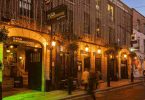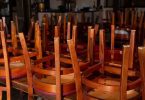Wines and Falls in Niagara
 For those that fancy wine touring, finding the right area is often a problem. You’re often travelling with a companion that’s not as much of an enthusiast as you are, it can involve an awful lot of driving and it’s not always easy to combine wine visits with some lively city life. Well, how about trying the Canadian region of Ontario?
For those that fancy wine touring, finding the right area is often a problem. You’re often travelling with a companion that’s not as much of an enthusiast as you are, it can involve an awful lot of driving and it’s not always easy to combine wine visits with some lively city life. Well, how about trying the Canadian region of Ontario?
It’s got some truly interesting cool climate wines, the distances between wineries isn’t great, there are coach tours available locally, and it’s next door to one of the tourist wonders of the world, Niagara Falls. If that’s not enough, it’s only a short car or train journey to Toronto, where you can dine, shop and sightsee to your heart’s content. If you enjoy wine tasting and fancy North America in the fall, it could be the very place.
I discovered this quite by accident on a recent trip to New York, when I decided to visit the Niagara wine region as a form of add-on. There isn’t much Canadian wine on the Irish market but I began my tour by focusing on what’s available here and that’s mainly Inniskillin and Jackson Triggs (Findlater). Both labels are owned by the same firm, as it happens, and they are one of Canada’s largest producers at 100,000 cases. The estate was founded by Karl Kaiser, who came to Canada from Austria about 40 years ago and was underwhelmed, to say the least, by Canada’s wines and the penchant for local vitis labrusca grapes. These are different from vitis vinifera, the vine species responsible for most of the  world’s quality wines.
world’s quality wines.
Wines made from labrusca and other native American varieties tend to have less acidity, with a rather confected, bubble gum like aroma and flavour. This character is often described as “foxy”. The origin of that term is not clear and some drinkers assume it means earthy or animal-like. My own guess is that it may derive from the French word “faux” and was possibly applied to local grapes and wines by French settlers in the area, owing to their false or incorrect character when compared with vitis vinifera.
Nowadays all quality wine of the region is produced from vinifera, although some estates produce labrusca and hybrid (vine crossings between vinifera and labrusca) based wines, mainly for local consumption. The only exception to the vinifera advance is the case of ice wine. Widely made in the Niagara region from frozen grapes, these wines are often produced from hybrids such as vidal, as well as from riesling and sometimes cabernet franc.
Inniskillin is among the more commercially oriented of Niagara’s wineries in that wines are decent and good value, with sufficient quantities for export. Of the smaller outfits, I was particularly impressed with Pilliteri, where the winemaker is a young Australian, Mark Bradshaw. A glutton for punishment, he came to Canada because he relished the challenge of making wine in a marginal climate. “Ice wine is our flagship here,” he says, “but there’s a real satisfaction when you make a great table wine against the odds.” Cabernet franc and merlot perform more consistently in Niagara than cabernet sauvignon, and 2007 was the vintage of the decade, with great ripeness and concentration. The Pilliteri wines are excellent for that year but some barrel samples of later vintages look promising too.
Flat Rock is run by the Madronich family, with a production of around 15,000 cases and some white wines which could stand comparison with anything in the world. You don’t find here the occasional reluctance to show anything other than the stellar 2007. Using Burgundy clones, Ed Madronich produces some fine chardonnay and what must be some of the best riesling in Canada. The 2006 has lovely floral notes with a terrific steely intensity and flavours of ripe Bramley apples.
With a bottle of this stuck safely into the backpack, it was straight on to Niagara Falls and, after dutifully doing the tourist romp, settling down to a dinner of Flat Rock with fresh, locally caught fish. Next day brought a train journey to Toronto and first stop for foodies has to be the St Lawrence market. If you’re staying at a hotel, this is the kind of place where you wish you were self catering but, in compensation, keenly priced lunches from poppingly fresh local ingredients can be had from any number of stalls. It’s also a good place to sample Canadian wines because the restaurants of Toronto don’t offer all that many and, when they do, the mark up is stiff. At St Lawrence Wine Market there are daily tastings – so even if you never leave Toronto, you can have a snapshot of the region’s wines.
My last glimpse of the Toronto hinterland was from the CN Tower, with its breathtaking views of the city and surroundings. It’s horribly expensive, awfully hot and filled with parties of chatty children but it’s worth the effort. Go early in the day to avoid the crowds or, if you fancy eating at altitude, book dinner at the top floor 360 Restaurant just before dark and save yourself the elevator fee. The restaurant lays claim to the highest wine cellar in the world (at 1,151 feet) and has 9,000 bottles with 550 different wines. That surely qualifies it as the perfect place to round off a wine tour.
For more information check out www.niagrawines.com which has a extensive list of wineries and local attractions. Those interested in importing wines can contact individual wineries by email or the PR and marketing executive at Wines of Ontario, Magdalena Kaiser Smit: magdalena@winesofontario.org. Transat fly regularly from Dublin to Toronto and Montreal.








